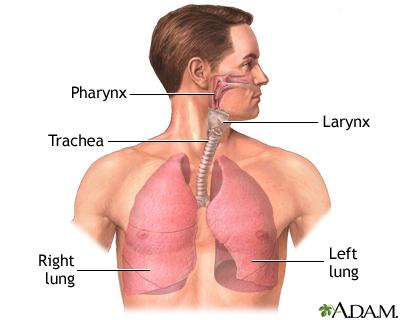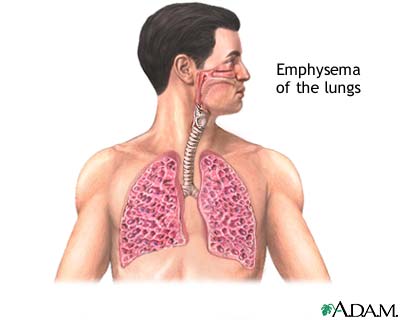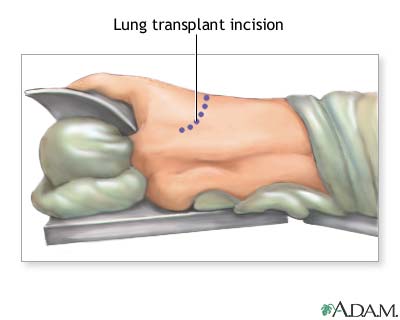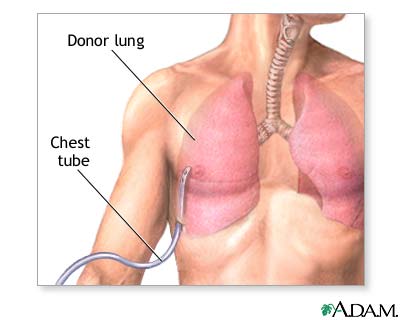Health Library
Lung transplant - series

Normal anatomy
The lungs, which reside in the thorax, or chest cavity, act as a site for oxygen and carbon dioxide exchange for the blood.

Indication
Lung transplants may be recommended for patients with severe lung disease such as:
- Permanent enlargement of air sacs (alveoli) with loss of ability to completely exhale (emphysema)
- Hereditary lung blockages (cystic fibrosis)
- Long-term (chronic) infections (sarcoidosis)
- Permanent scarring and thickening of lung tissue (idiopathic pulmonary fibrosis)

Incision
While the patient is deep asleep and pain-free (general anesthesia), an incision is made through the breast bone (sternum). One or two donor lungs are transplanted, depending on the diease process being treated.

Procedure
Tubes are used to re-route the blood to a heart-lung bypass machine to keep the blood oxygenated and circulating during the surgery.
The patient's lungs are removed and the donor lungs are stitched into place. Drainage tubes (chest tubes) are inserted to drain air, fluid, and blood out of the chest for several days to allow the lungs to fully re-expand.

Aftercare
The patient's lungs are removed and the donor lungs are stitched into place. Drainage tubes (chest tubes) are inserted to drain air, fluid, and blood out of the chest for several days to allow the lungs to fully re-expand.
Patients will require immunosuppressive medications for the rest of their lives to prevent immune rejection of the transplanted lung. Lung transplantation results vary depending on the disease being treated and the experience of the center performing the surgery.
BACK TO TOP
Review Date: 4/24/2021
Reviewed By: Mary C. Mancini, MD, PhD, Director, Cardiothoracic Surgery, Christus Highland Medical Center, Shreveport, LA. Review provided by VeriMed Healthcare Network. Also reviewed by David Zieve, MD, MHA, Medical Director, Brenda Conaway, Editorial Director, and the A.D.A.M. Editorial team.
 | A.D.A.M., Inc. is accredited by URAC, for Health Content Provider (www.urac.org). URAC's accreditation program is an independent audit to verify that A.D.A.M. follows rigorous standards of quality and accountability. A.D.A.M. is among the first to achieve this important distinction for online health information and services. Learn more about A.D.A.M.'s editorial policy, editorial process and privacy policy. A.D.A.M. is also a founding member of Hi-Ethics. This site complies with the HONcode standard for trustworthy health information: verify here. |
The information provided herein should not be used during any medical emergency or for the diagnosis or treatment of any medical condition. A licensed medical professional should be consulted for diagnosis and treatment of any and all medical conditions. Links to other sites are provided for information only -- they do not constitute endorsements of those other sites. © 1997- 2021 A.D.A.M., a business unit of Ebix, Inc. Any duplication or distribution of the information contained herein is strictly prohibited.
